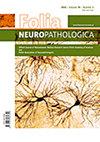A current view of mitochondria damage and the diversity of lipopigment inclusions in neuronal ceroid lipofuscinose type 2 from rectal biopsy
IF 1.6
4区 医学
Q4 NEUROSCIENCES
引用次数: 0
Abstract
Neuronal ceroid lipofuscinoses (NCLs) are a growing group of neurodegenerative storage diseases, in which specific features are sought to facilitate the creation of a universal diagnostic algorithm in the future. In our ultrastructural studies, the group of NCLs was represented by the CLN2 disease caused by a defect in the TPP1 gene encoding the enzyme tripeptidyl-peptidase 1. A 3.5-year-old girl was affected by this disease. Due to diagnostic difficulties, the spectrum of clinical, enzymatic, and genetic tests was extended to include analysis of the ultrastructure of cells from a rectal biopsy. The aim of our research was to search for pathognomonic features of CLN2 and to analyse the mitochondrial damage accompanying the disease. In the examined cells of the rectal mucosa, as expected, filamentous deposits of the curvilinear profile (CVP) type were found, which dominated quantitatively. Mixed deposits of the CVP/fingerprint profile (FPP) type were observed less frequently in the examined cells. A form of inclusions of unknown origin, not described so far in CLN2 disease, were wads of osmophilic material (WOMs). They occurred alone or co-formed mixed deposits. In addition, atypically damaged mitochondria were observed in muscularis mucosae. Their deformed cristae had contact with inclusions that looked like CVPs. Considering the confirmed role of the c subunit of the mitochondrial ATP synthase in the formation of filamentous lipopigment deposits in the group of NCLs, we suggest the possible significance of other mitochondrial proteins, such as mitochondrial contact site and cristae organizing system (MICOS), in the formation of these deposits. The presence of WOMs in the context of searching for ultrastructural pathognomonic features in CLN2 disease also requires further research.线粒体损伤和直肠活检发现的 2 型神经元类脂膜脂褐质内含物多样性的最新观点
神经细胞类脂膜炎(NCLs)是一类日益增多的神经退行性储积疾病,我们正在寻找其具体特征,以便将来建立通用的诊断算法。在我们的超微结构研究中,由编码三肽基肽酶 1(tripeptidyl-peptidase 1)的 TPP1 基因缺陷引起的 CLN2 疾病是 NCLs 的代表。一名 3.5 岁的女孩患有这种疾病。由于诊断困难,临床、酶学和基因检测的范围扩大到包括对直肠活检细胞超微结构的分析。我们的研究目的是寻找 CLN2 的病理特征,并分析伴随该疾病的线粒体损伤。不出所料,在检查的直肠粘膜细胞中发现了曲线型(CVP)的丝状沉积物,这种沉积物在数量上占主导地位。在受检细胞中较少观察到 CVP/ 指纹轮廓(FPP)型混合沉积物。一种来源不明的包涵体是嗜锇物质包块(WOMs),迄今为止在CLN2疾病中尚未发现。它们单独或共同形成混合沉积物。此外,在粘膜肌肉中还观察到非典型受损的线粒体。它们变形的嵴与看起来像 CVPs 的内含物有接触。考虑到线粒体 ATP 合成酶 c 亚基在 NCLs 中丝状脂质沉积物形成过程中的作用已得到证实,我们认为其他线粒体蛋白,如线粒体接触点和嵴组织系统(MICOS),在这些沉积物的形成过程中也可能发挥重要作用。在寻找CLN2疾病超微结构病理特征的过程中,WOMs的存在也需要进一步研究。
本文章由计算机程序翻译,如有差异,请以英文原文为准。
求助全文
约1分钟内获得全文
求助全文
来源期刊

Folia neuropathologica
医学-病理学
CiteScore
2.50
自引率
5.00%
发文量
38
审稿时长
>12 weeks
期刊介绍:
Folia Neuropathologica is an official journal of the Mossakowski Medical Research Centre Polish Academy of Sciences and the Polish Association of Neuropathologists. The journal publishes original articles and reviews that deal with all aspects of clinical and experimental neuropathology and related fields of neuroscience research. The scope of journal includes surgical and experimental pathomorphology, ultrastructure, immunohistochemistry, biochemistry and molecular biology of the nervous tissue. Papers on surgical neuropathology and neuroimaging are also welcome. The reports in other fields relevant to the understanding of human neuropathology might be considered.
 求助内容:
求助内容: 应助结果提醒方式:
应助结果提醒方式:


